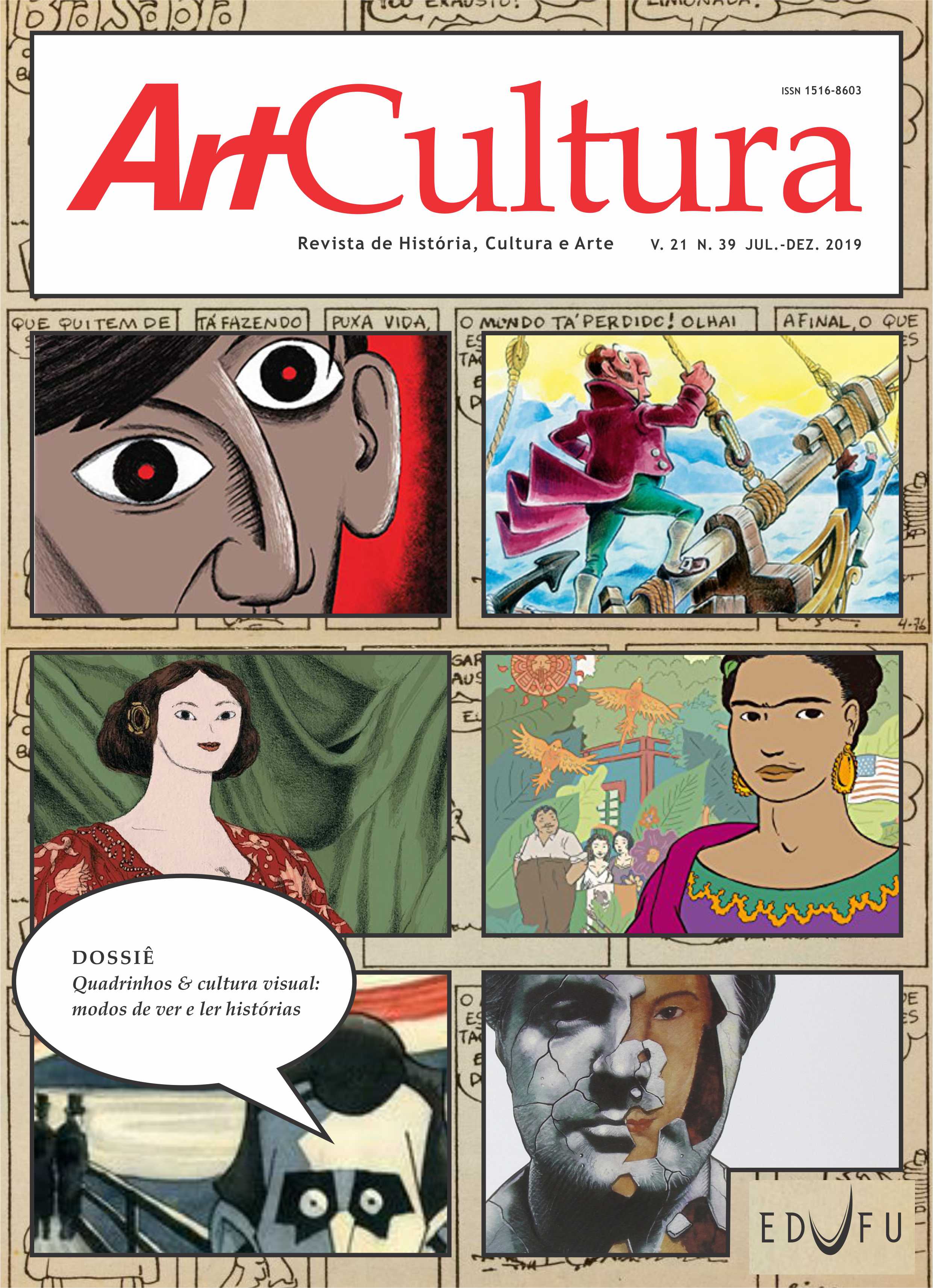Graphic readings of the city: Rio de Janeiro on the street comics Zé Ninguém
DOI:
https://doi.org/10.14393/artc-v21-n39-2019-52024Keywords:
Comics, graffitti, Rio de JaneiroAbstract
After leaving New York in 2001to adopt the city of Rio de Janeiro, Tito na Rua started to work with graffiti to print its brand as a new resident of the city. He created a street comics called Zé Ninguém, a comics narrative whose title character lives his adventures as he wanders through the walls and alleys of Rio de Janeiro. Through Zé Ninguém we intend to discuss the possibilities of interlocution between the technical and visual procedures typical of two graphic and urban arts such as comics and graffiti. The connections between urban art and apprehension of public space, reading of art in terms of reading the city and the creative solutions suggested by intermediality are main topics developed throughout the text, starting from a perspective that historicizes the practices of looking and questions the role of the arts in the city experience.
Downloads
References
AHRENS, J.; METELING, A. (eds.). Comics and the city: urban space in print, picture and sequence. New York/London: Continuum, 2010.
ARGAN, Giulio Carlo. A história da arte como história da cidade. São Paulo: Martins Fontes, 1992.
BAETENS, Jan e FREY, Hugo. The graphic novel: an introduction. New York: Cambridge University Press, 2015.
BALL, David e KUHLMAN, Martha (eds.). The comics of Chris Ware: drawing is a way of thinking. Jackson: University Press of Mississipi, 2010.
BALABAN, Marcelo. Poeta do lápis: sátira e política na trajetória de Angelo Agostini no Brasil Imperial (1864-1888). Campinas: Editora da Unicamp, 2009.
BECKER, H. Art worlds and social types. American Behavioral Scientist, v. 19, n. 6, s./l., 1976.
BREDEHOFT, Thomas. The visible text: textual production and reproduction from Beowulf to Maus. Oxford: Oxford University Press, 2014.
CALVINO, Ítalo. As cidades invisíveis. São Paulo: Companhia das Letras, 1990
COLOMBINO, Jader. Notícias: Zé Ninguém. Porto Maravilha, 1 abr. 2015.
DIAS, Elaine Cristina. Debret: a pintura de História e as ilustrações de Corte da Viagem Pitoresca e Histórica ao Brasil. 2001. Dissertação (Mestrado em História) – Unicamp, Campinas, 2001.
DITTMER, Jason. Narrating urban assemblages – Chris Ware and Building Stories. Social & Cultural Geography, v. 15, n. 5, s./l., 2014.
DOMINGUES, Bruno Willian Brandão. A cidade das aquarelas: o Rio de Janeiro nos registros de Jean-Baptiste Debret. Dissertação (Mestrado em História Social) – PUC-SP, São Paulo, 2018.
DUNNET, Oliver. Identity and geopolitics in Hergé’s Adventures of Tintin. Social and Cultural Geography, v. 10, n. 5, s/l., jun. 2009.
ECO, Umberto. The myth of Superman. Diacritics, v. 2, n. 1, Baltimore, mar.-maio 1972.
EXPILLY, Charles. Le Brésil tel qu’il est. 2. ed. Paris: Charlieuet Huillery Libraires Editeurs, 1863.
FERRELL, Jeff. Crimes of style: urban graffiti and the politics of criminality. Boston: Northeastern University Press, 1996.
FREIRE-MEDEIROS, Bianca. O Rio de Janeiro que Hollywood inventou. Rio de Janeiro: Jorge Zahar, 2005.
FOSTER, Hal. Recodings: art, spectacle, cultural politics. 2. ed. San Francisco: Bay Press, 1987.
GROVE, Laurence. Comics in French: the European bande dessinée in context. Oxford/New York: Berghahn Books, 2010.
HARVEY, David. The right to the city. New Left Review, s/v., n. 53, London, set.-out. 2008.
KANNENBERG, Gene. Graphic text, graphic context: interpreting custom fonts and hands in contemporary comics. In: GUTJAHR, Paul; BENTON, Megan (orgs.). Illuminating letters: typography and literary interpretation. Boston: University of Massachusetts Press, 2001.
KING, Edward; PAGE, Joanna. Posthumanism and the graphic novel in Latin America. London: UCL Press, 2017
KNAUSS, Paulo. Grafite urbano contemporâneo. In: TORRES, Sônia (org.). Raízes e rumos: perspectivas interdisciplinares em estudos americanos. Rio de Janeiro: 7Letras, 2001.
KRAMER, Ronald. The rise of legal graffiti writing in New York and beyond. Cingapura: Palgrave Macmillan/Springer Nature, 2017.
MCCORMICK, Carlo; ROBINSON, Walter. Report from the East Village: slouching toward Avenue D. In: THOMPSON, Margo. American graffiti. New York: Parkstone International, 2009.
NORA, Pierre. Entre memória e história. A problemática dos lugares. Projeto História, v. 10, s/n., São Paulo, jul.-dez. 1993.
O’DONNEL, Julia. A invenção de Copacabana: culturas urbanas e estilos de vida no Rio de Janeiro. Rio de Janeiro: Editora Zahar, 2013.
OLIVEIRA, Flávia. Portfolio Alberto Serrano “Tito”, 14 mar. 2013.
PEREIRA, Sonia Gomes. Arte no Brasil no século XIX e início do XX. In: OLIVEIRA, Myriam Andrade Ribeiro de. (ed.). História da arte no Brasil: textos de síntese. 3. ed. Rio de Janeiro: Editora UFRJ, 2013.
PESAVENTO, Sandra Jatahy. Muito além do espaço: por uma história cultural do urbano. Estudos Históricos, v. 8, n. 16, Rio de Janeiro, 1995.
RODRIGUEZ, Diogo. Quadrinhos de rua. Revista Trip, 19 jan. 2011.
SERRANO, Alberto (Tito na Rua). Zé Ninguém. Rio de Janeiro: Edições de Janeiro, 2015.
SMOLDEREN, Thierry. Origins of comics : from William Hogarth à Winsor McCay. Jackson: University Press of Mississipi, 2014.
THOMÉ, Clarissa. ‘Zé Ninguém', personagem de 150 grafites, vira livro. Estadão, 3 mar. 2015.
VARTANIAN, Hrag. Rio’s street graphic novelist: an interview with Tito na Rua. BrazilNYC, 22 jun. 2009.
Downloads
Published
How to Cite
Issue
Section
License
Autores que publicam nesta revista concordam com os seguintes termos da licença Creative Commons, adotada a partir da ArtCultura, v. 21, n. 39 (jul.-dez. 2019).
CC BY-NC-ND 4.0: o artigo pode ser copiado e redistribuído em qualquer suporte ou formato. Os créditos devem ser dados ao autor original e mudanças no texto devem ser indicadas. O artigo não pode ser usado para fins comerciais. Caso o artigo seja remixado, transformado ou algo novo for criado a partir dele, ele não pode ser distribuído.
Autores têm autorização para assumir contratos adicionais separadamente, para distribuição não exclusiva da versão do trabalho publicada nesta revista (ex.: publicar em repositório institucional ou como capítulo de livro), com reconhecimento de autoria e publicação inicial nesta revista.


